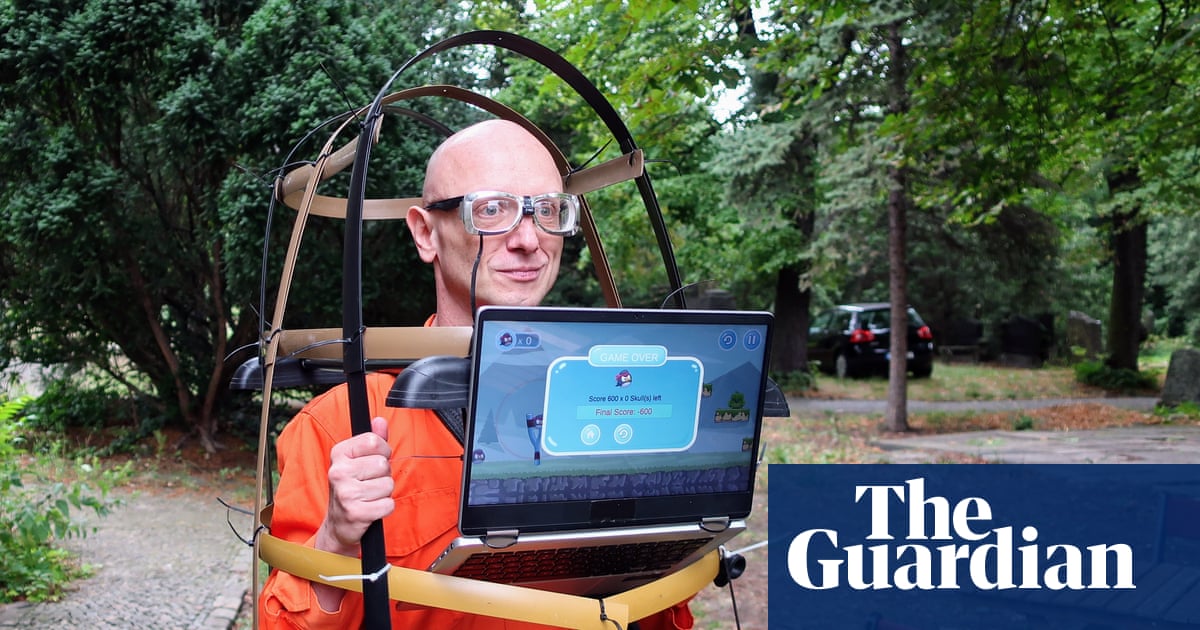As the crowd outside a gallery in central Berlin filters indoors to get out of the rain, a man in a bright red T-shirt wearing cartoonishly large metal-framed glasses heads in the opposite direction.
With a retro futuristic yellow bike helmet under his arm and an orange backpack stuffed full of rain gear slung over his shoulder, Patrick Jambon, a 58-year-old Frenchman, leaves Galerie Neu and makes for his bike. The rain is not stopping him from making the most ofBerlin’s gallery weekend, when many of Berlin’s400-plus galleriesexhibit new shows over three days.
Because Jambon, who goes by the nomes de plume “Mr Jambon” or “Turbojambon”, is not visiting galleries as an ordinary culture vulture, but as part of a non-stop performance art piece, now entering its 25th year.
Every day Jambon spends a few hours compiling a list of gallery openings from websites such asIndex Berlinand social media accounts, jotting each opening on a scrap of paper. Then he begins hitting the galleries on his list, going from one to the next while decked out in his vibrant outfit and bug-eye glasses. He calls it his “gallery project”.
“You aren’t a real Berlin artist if you don’t know him,” says the Korean-American visual artistAe Hee Lee. Always the most colourfully dressed in the room, he sticks out at any opening he attends, and he attends many. In the 25 years that Jambon has lived in Berlin, he estimates that he has been to more than 6,000.
When Berlin gallery weekend comes around, Jambon’s project goes into overdrive. Several years ago, he went to 25 galleries in a single day. This year, Jambon went to just over a dozen, but his project was present in more ways than one. Ducking into Berlin-Weekly, an art project space in Mitte, Mr Jambon pointed to a framed piece of paper with small handwriting in neat vertical columns. It was one of his gallery opening lists. Berlin-Weekly’s featured artist and curator, Sebastian Klug, had asked Mr Jambon if he could include one of his lists in the show. “It’s part of the arts scene,” Klug says.
Originally from Lyon, France, Mr Jambon moved to westernGermanywhen he was 21 to study animation and video art at the Academy of Art in Düsseldorf and the Academy of Media Arts in Cologne.
In his early 30s, he had grown tired of sitting in front of a computer to work on his animations, so in 2000 he decided to move to Berlin and pursue performance art. “Relatively early on I realised that I missed interacting with an audience,” Jambon said at a gallery opening in Berlin in late November.
In the German capital, he started to attend public events dressed as portable structures made from ready-made objects:a ladderon his head that grows taller as people add more rungs, a monitor strapped to his back on which strangers canplay video games, akaraoke machinehanging on his chest. His goal is to interact with his audience and get them moving. “People think that performers have to do something, to be active, and that the onlookers must be passive,” Jambon said. “I want to reverse this.”
Over time, he simplified and intensified his practice. The portable structures mostly stayed at home, but Jambon continued to go out. Before moving to Berlin, Jambon wasn’t much of a gallery fiend, but “when I came to Berlin, I didn’t know that many people so I started going to many galleries and exhibits,” he said. “It became a habit.”
What started as a habit developed into an everyday performance. “I don’t do much, but I interact with the public,” he says.
Throughout his gallery crawl last Friday night, people wave, smile and shake his hand. One young man standing outside gallery HVW8 Berlin in Mitte shouts “Hi” as Jambon bikes by. Another person stops him outside gallery BQ in Prenzlauer Berg to ask if he’s seen anything good today. A third approaches him outside Dittrich & Schlechtriem gallery near Rosa Luxemburg Platz to ask which galleries are still open.
“Many people say hi to me, but I don’t know who they are, or sometimes I only remember who they are later,” Jambon says.
But as the night goes on and the crowds thin out, artists and curators sip wine outside closing galleries, and Jambon’s interactions become more drawn out. Outside Galeria Plan B, Jambon strikes up a conversation with someone he hasn’t seen in a while.
“Are you still making your lists?” the man asks Jambon.
“It’s the longest list I’ve ever made,” Jambon replies, holding it in front of him as the guy snaps a photo.
Jambon used to be part of an entire scene of Berlin performance artists who embraced a similar practice. There were EVA & ADELE, an androgynous Austro-German artist duowho pretended to have visited Berlin from the futureand announced: “Wherever we are is museum”. There was Konstantin Schneider, who called himselfKunstkontakterand visited galleries with a camera attached to his hard hat.
But when Jambon bumped into Schneider at a gallery earlier this year, his former comrade-in-art was in “incognito mode”: his health, he said, had forced him to dress up less and attend fewer galleries. Since the pandemic, Jambon says, he has seen a drop among gallery-goers. While many arts spaces in Berlin were able to survive lockdown due to Berlin’s generous state funding for the arts – subsidies that have recently been drastically reduced – he estimates that people simply lost their habit of attending gallery opening. “There are some people I never saw at exhibitions again,” he says.
Still, Mr Jambon plods along with his project. “Some people leave or go elsewhere,” he says, “but there is no real alternative. There is no city like Berlin anywhere else.”
